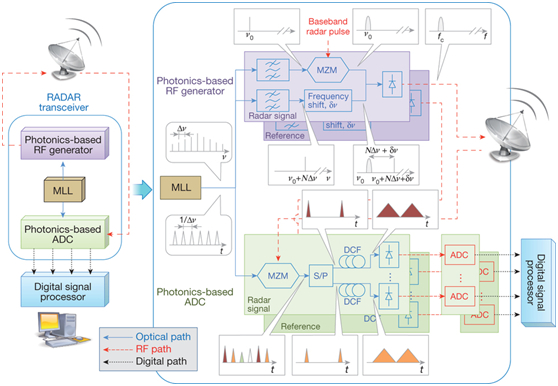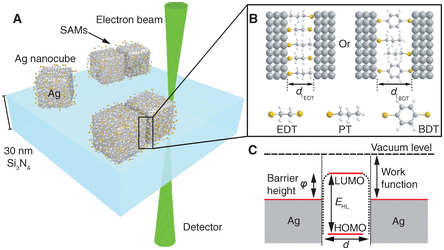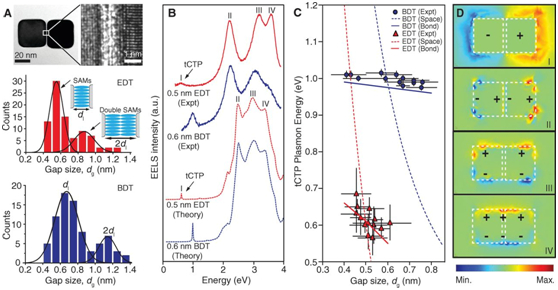一、本期重点:
doi:10.1038/nature13078
published : 2014.3.19
下一代雷达系统(无线电探测和测距)需要基于软件定义的无线电,以适应各种环境,使之天线更小的同时有较高的载波频率和分辨率更高的同时有更宽的带宽。当今的数字微波元件(合成器和模拟-数字转换器),在频率增加时带宽有限,并且噪声增加,因此全数字雷达系统最多能在几个GHz的高频时工作,一些噪声在高频时也需要考虑。与此相反,光子学提供更高的精度和超宽的带宽,同时允许灵活生成一直到毫米波的极其稳定的任意波形的射频信号,也能实现该信号的检测,它们能精确地直接数字化而不降频。到现在为止,以光子学为基础的射频信号的产生和检测都被单独研究,且未在雷达系统中进行测试。在这里,我们展示了一个全光基础的相干雷达的发展和现场试验。所提出的架构利用一个单脉冲激光器,其产生可调谐的雷达信号,并接收其回波,避免无线电频率上下变频,同时保证了软件定义的方式和高分辨率。它的性能超过了最先进的载波频率超过2GHz的电子设备,通过试验证实了有效性和预期的系统精度。

图一 以光子学为基础的雷达的体系结构图

图二 以光子学为基础的射频发生器的测试结果。a、射频信号的相位噪声曲线。b、雷达信号的幅度和相位变化图。c、编码和未编码的射频谱比较
doi : 10.1126/science.1248797
published : 2014.3.28
内容介绍:
两个等离子谐振器之间的量子隧道效应把非线性量子光学与太赫兹纳米电子学联系到一起。我们直接观察并控制量子等离子谐振,它的长度范围是0.4至1.3纳米,横穿由自组装单分子层桥连的两个等离子谐振腔组成的分子隧道结。隧道势垒的宽度和高度是由分子的特性进行控制。利用电子能量损失谱,我们直接观察到了一个等离子体模式,隧穿电荷转移等离子体,其频率(范围从140到245太赫兹)是依赖于桥接间隙的分子。

图一:量子等离子隧道结 A、由两个纳米银颗粒通过自组装单分子层桥连的分子隧穿结示意图。B、两个相邻的纳米颗粒的距离由单分子层厚度决定。C、隧穿结的能级结构示意图。

图二:直接观察到的等离子谐振腔之间的量子隧穿现象。A、电镜下的隧穿结像。B、理论预期和实验观察到的电子能量损失谱。C、实验测到的等离子能量石间隙大小的函数。D、等离子模式的电场分布的仿真图。
二、 简讯:
doi:10.1038/nmeth.2922
published :2014.4.6
Abstract:
Light-sheet microscopy facilitates rapid, high-contrast, volumetric imaging with minimal sample exposure. However, the rapid divergence of a traditional Gaussian light sheet restricts the field of view (FOV) that provides innate subcellular resolution. We show that the Airy beam innately yields high contrast and resolution up to a tenfold larger FOV. In contrast to the Bessel beam, which also provides an increased FOV , the Airy beam's characteristic asymmetric excitation pattern results in all fluorescence contributing positively to the contrast, enabling a step change for light-sheet microscopy.
doi:10.1038/nmeth.2919
published :2014.4.6
Abstract:
When excited with rotating linear polarized light, differently oriented fluorescent dyes emit periodic signals peaking at different times. We show that measurement of the average orientation of fluorescent dyes attached to rigid sample structures mapped to regularly defined (50nm)2 image nanoareas can provide subdiffraction resolution (super resolution by polarization demodulation, SPoD). Because the polarization angle range for effective excitation of an oriented molecule is rather broad and unspecific, we narrowed this range by simultaneous irradiation with a second, de-excitation, beam possessing a polarization perpendicular to the excitation beam (excitation polarization angle narrowing, ExPAN). This shortened the periodic emission flashes, allowing better discrimination between molecules or nanoareas. Our method requires neither the generation of nanometric interference structures nor the use of switchable or blinking fluorescent probes. We applied the method to standard wide-field microscopy with camera detection and to two-photon scanning microscopy, imaging the fine structural details of neuronal spines
doi:10.1038/srep04535
published:2014.4.3
Abstract:
Broadband light sources play essential roles in diverse fields, such as high-capacity optical communications, optical coherence tomography, optical spectroscopy, and spectrograph calibration. Although a nonclassical state from spontaneous parametric down-conversion may serve as a quantum counterpart, its detection and characterization have been a challenging task. Here we demonstrate the direct detection of photon numbers of an ultrabroadband (110 nm FWHM) squeezed state in the telecom band centred at 1535 nm wavelength, using a superconducting transition-edge sensor. The observed photon-number distributions violate Klyshko's criterion for the nonclassicality. From the observed photon-number distribution, we evaluate the second- and third-order correlation functions, and characterize a multimode structure, which implies that several tens of orthonormal modes of squeezing exist in the single optical pulse. Our results and techniques open up a new possibility to generate and characterize frequency-multiplexed nonclassical light sources for quantum info-communications technology.
doi: 10.1021/nl500658n
published :2014.4.3
Abstract:
Light beams with orbital angular momentum have significant potential to transform many areas of modern photonics from imaging to classical and quantum communication systems. We design and experimentally demonstrate an ultracompact array of nanowaveguides with a circular graded distribution of channel diameters that coverts a conventional laser beam into a vortex with an orbital angular momentum. The proposed nanoscale beam converter is likely to enable a new generation of on-chip or all-fiber structured light applications.
doi: 10.1021/nl404707t
published :2014.4.3
Abstract:
We introduce strongly-coupled optical gap antennas to interface optical radiation with current-carrying electrons at the nanoscale. The transducer relies on the nonlinear opticaland electrical properties of an optical gap antenna operating in the tunneling regime. We discuss the underlying physical mechanisms controlling the conversion and demonstrate that a simple two-wire optical antenna can provide advanced optoelectronic functionalities beyond tailoring the electromagnetic response of a single emitter. Interfacing an electronic command layer with a nanoscale optical device may thus be facilitated by the opticalrectennas discussed here.
doi: 10.1126/science.1248905
published:2014.3.27
Abstract:
Multiparticle entanglement enables quantum simulations, quantum computing and quantum-enhanced metrology. Yet, there are few methods to produce and measure such entanglement while maintaining single-qubit resolution as the number of qubits is scaled up. Using atom chips and fiber-optical cavities, we have developed a method based on non-destructive collective measurement and conditional evolution to create symmetric entangled states and perform their tomography. We demonstrate creation and analysis of entangled states with mean atom numbers up to 41 and experimentally prove multiparticle entanglement. Our method is independent of atom number and should allow generalization to other entangled states and other physical implementations including circuit quantum electrodynamics.
供稿:段昌琪







